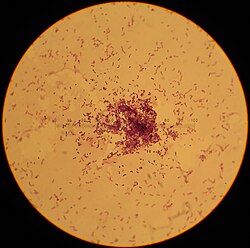热门问题
时间线
聊天
视角
乳酸乳球菌
来自维基百科,自由的百科全书
Remove ads
乳酸乳球菌(拉丁語:Lactococcus lactis)是一種廣泛用於生產酪漿和奶酪的革蘭氏陽性菌[1] ,亦是第一個被基因改造、活體使用於治療人類疾病的生物[2]。其為卵形的球菌,以成對的短鏈分組。取決於增長的條件,長度在0.5-1.5微米之間。它是內生孢子,不會向外產生孢子,亦不具有能動性。
Remove ads
乳酸乳球菌擁有一種自發酵的新陳代謝方式,可以通過糖類產生乳酸。據報告,它能夠產生獨特的L-(+)-乳酸[3] ,在pH值較低的環境下也能生成D-(−)-乳酸[4] 。正是這種可以產生乳酸的特性使其成為乳製品企業中最重要的微生物之一[5]。由於其運用在食物發酵上已有較長的歷史,它獲得了公認安全 (GRAS)的評價[6][7] ,而鮮少有成為潛在病原體的報告[8][9][10]。
乳酸乳球菌在生產如酪漿和奶酪等奶製品時具有至關重要的地位。當它的L. l. lactis亞種被添加進牛奶時,它會使用酶從乳糖中產生能量分子(ATP),在此過程中產生副產物——乳酸。它會凝結牛奶,使其分離以形成凝乳,在生產中再使之進一步變成奶酪[11] 。另外已有報告的乳酸乳球菌的其他用途還包括:泡菜、啤酒、葡萄酒、幾種麵包和其他發酵食品,諸如豆奶、乳酒、酪漿等[12] 。它是人們在遺傳學、新陳代謝和生物多樣性上了解最細緻的低GC含量的革蘭氏陽性菌之一[13][14]。
乳酸乳球菌主要是從乳製品環境或植物材料中分離得出[15][16][17]。乳製品環境中的分離是從植物分離所進化而來:一道工序使得不在富饒的牛乳環境中具有優勢的基因要麼從此消失,要麼被限制表達[18]。這一工序也叫做基因組侵蝕或還原性進化,也於其他數種乳酸菌中可見[19][20]。在實驗室中,植物分離之後的乳酸菌培養株在實驗模擬下經歷長時間的進化,最終達到預計的乳製品環境中分離的結果。與比較基因組學得到的結果(參見之前的參考文獻)一致的是,乳酸乳球菌中在牛奶里可有可無的基因消失或被限制表達,而有助於肽運輸的基因的表達反而被擴大了[21]。
Meulen等人在編號為MG1363的乳酸乳球菌里發現了數以百計的新型小RNA,其中一個(LLnc147)顯示出與碳吸收和新陳代謝有關[22]。
Remove ads
奶酪的生產
乳酸乳球菌的亞種L. l. lactis(之前被叫做乳鏈球菌)[23]被使用在許多奶酪(包括布里、卡芒貝爾、切達、考爾比、格呂耶爾、帕馬森和羅克福)生產的早期階段[24]。美國奶酪產量第一的威斯康星州州議會在2010年曾投票決定乳酸乳球菌為法定的「象徵州的微生物」。 此為第一個也是唯一一個通過州立法來指定某一象徵州的微生物的例子[25] ,但是卻未被國家參議院通過[26]。該法案在2009年以第556號議會法案的名義,由議員赫布爾(Hebl)、弗魯溫克(Vruwink)、威廉斯(Williams)、帕什(Pasch)、達努(Danou)和菲爾茲(Fields)聯署,參議員泰勒(Taylor)共同贊助[27],並於2010年5月15日在州議會通過,4月28日被參議院否決[27]。
乳酸乳球菌的使用也還是給乳製品工廠帶來了問題。直接針對乳酸乳球菌的噬菌體會阻止對牛奶基質的完全新陳代謝(從而使乳酸不能產生,工廠生產失敗),每年帶來較大的經濟損失。一些流行病學研究指出,與乳酸乳球菌相關的噬菌體主要都是長尾噬菌體科的936、c2和P335這幾種[28]。
Remove ads
乳酸乳球菌的好處
Shuichi Nakamura、Yusuke V. Marimoto以及Seishi Kudo在他們的研究中試圖證明乳酸乳球菌所產生的某些發酵可以抑制致病細菌的能動性。使用沙門氏菌為實驗組,他們的團隊發現,乳糖發酵的某一產物(醋酸鹽)能夠干擾沙門氏菌鞭毛的旋轉運動,並導致其失去能動性[29]。
而在另一項由Zhang B.領導的研究中,研究人員創造了一株含有可抑制腫瘤轉移的肽(稱為KISS1)的質粒的乳酸乳球菌株,再次展示了乳酸乳球菌如何可被用來治療疾病。此菌株構建的成功促進了對癌細胞轉移和擴大的抑制,體現了乳酸乳球菌分泌這一特定肽的特質為將來癌症治療帶來了新的希望[30]。
參考文獻
外部連結
Wikiwand - on
Seamless Wikipedia browsing. On steroids.
Remove ads

